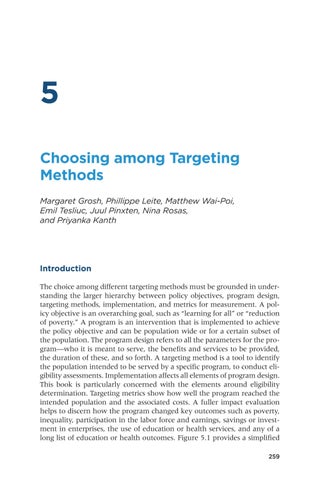5 Choosing among Targeting Methods Margaret Grosh, Phillippe Leite, Matthew Wai-Poi, Emil Tesliuc, Juul Pinxten, Nina Rosas, and Priyanka Kanth
Introduction The choice among different targeting methods must be grounded in understanding the larger hierarchy between policy objectives, program design, targeting methods, implementation, and metrics for measurement. A policy objective is an overarching goal, such as “learning for all” or “reduction of poverty.” A program is an intervention that is implemented to achieve the policy objective and can be population wide or for a certain subset of the population. The program design refers to all the parameters for the program—who it is meant to serve, the benefits and services to be provided, the duration of these, and so forth. A targeting method is a tool to identify the population intended to be served by a specific program, to conduct eligibility assessments. Implementation affects all elements of program design. This book is particularly concerned with the elements around eligibility determination. Targeting metrics show how well the program reached the intended population and the associated costs. A fuller impact evaluation helps to discern how the program changed key outcomes such as poverty, inequality, participation in the labor force and earnings, savings or investment in enterprises, the use of education or health services, and any of a long list of education or health outcomes. Figure 5.1 provides a simplified 259


